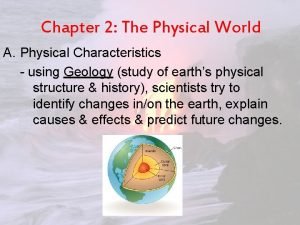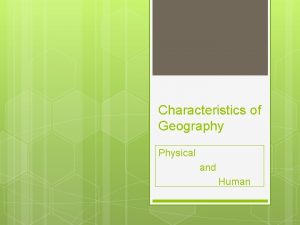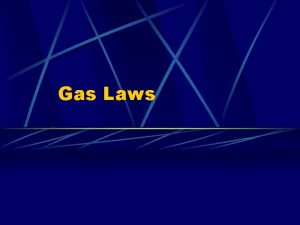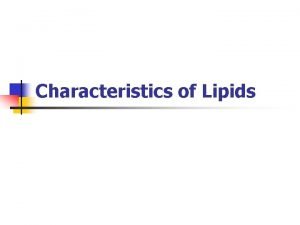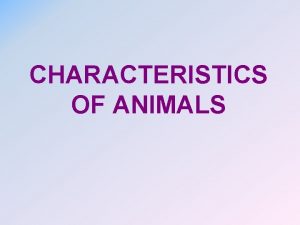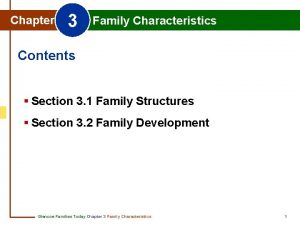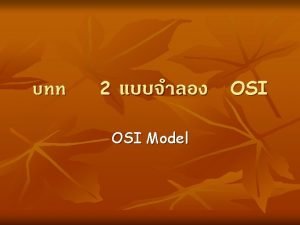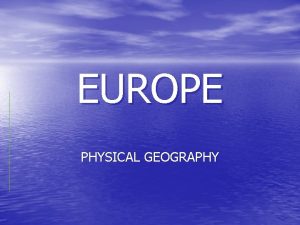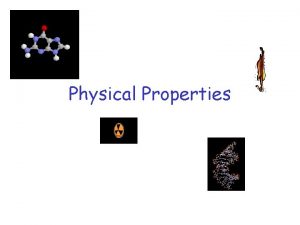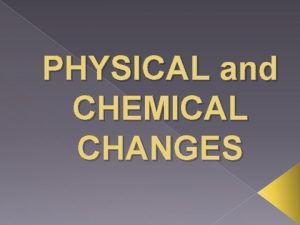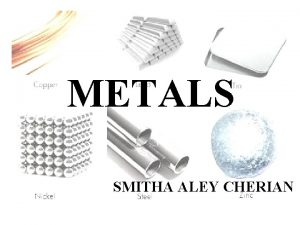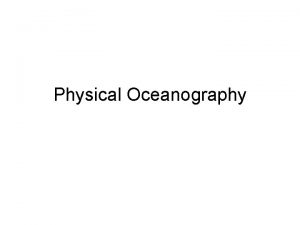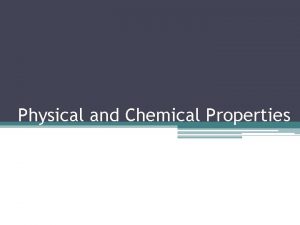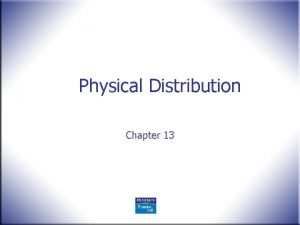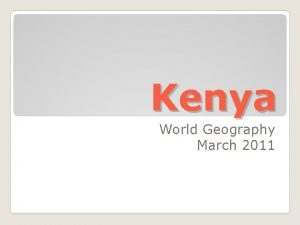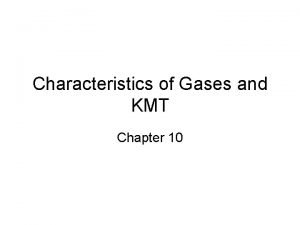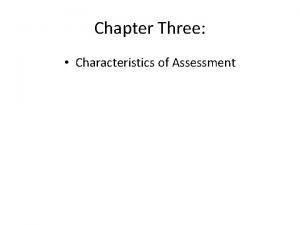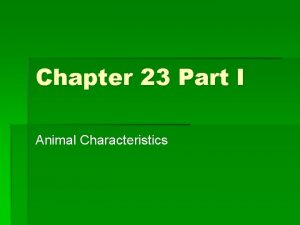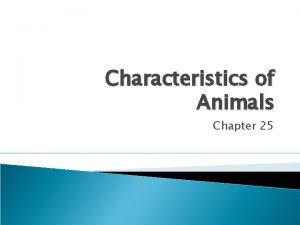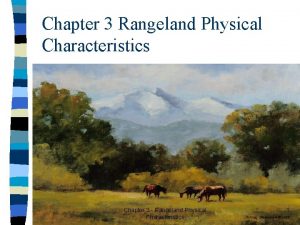Chapter 2 The Physical World A Physical Characteristics






























- Slides: 30

Chapter 2: The Physical World A. Physical Characteristics - using Geology (study of earth’s physical structure & history), scientists try to identify changes in/on the earth, explain causes & effects & predict future changes.

1. The Earth’s Layers a. Core: center of the earth; consists mostly of iron + some nickel 1) inner core: dense & solid 2) outer core: liquid b. Mantle: layer of thick, dense rock c. Crust: thin, rocky surface layer 1) thinnest below oceans (~4 mi. ) 2) thicker (avg 22 mi. ) beneath continents 3) natural forces act on crust creating landforms etc

2. Land, Air & Water a. Lithosphere: land that makes up the earth’s crust 1) ~30% of earth’s surface is land 2) continents (7 lrg land masses), islands, ocean floor 3) landforms (classified according to relief – diff. in elevation btwn high/low points), soil, rocks - see landform chart (mts, hills, plateaus, plains, valleys, canyons, basins, peninsulas, etc


b. Atmosphere: air, water, etc. above earth’s surface 1) extends about 1000 mi. above earth’s surface 2) 78% nitrogen, 21% oxygen, + carbon dioxide & other gasses 3) sustain life on earth 4) protect planet from Sun’s harmful radiation c. Hydrosphere: all of earth’s water 1) covers ~ 70% earth’s surface 2) not found on other planets in the solar system

d. Biosphere: part of earth where life is found - all people, plants & animals - all sphere’s are interconnected - what happens in one, affects the other(s)

B. Physical Processes - landforms are shaped by internal forces that originate in earth’s interior 1. Volcanoes a. Form when magma breaks through the earth’s crust. Molten rock is called lava when it reaches the surface b. The shape of volcano depends on type of eruption 1) shield: even flow of lava 2) cone: caused by sequence of explosive eruptions

2. Movement in the Crust a. Fold: result when rock layers bend & buckle b. Fault: a break in earth’s crust caused by stress on rocks c. Earthquakes: caused by large sudden movement along a fault

C. Understanding the Past - common belief that the earth’s landmasses have broken apart, rejoined & moved to other parts of the globe 1. Plate Tectonics a. Earth’s crust + brittle, upper layer of mantle is broken into a # of moving plates. These plates slide over a hot & flexible layer of the mantle b. Earth’s oceans & continents ride over atop plates as they move in different directions c. Most earthquakes, volcanoes & other geologic events occur along plate boundaries

Plate Tectonics

2. Continental Drift a. once a “supercontinent” (Pangea) which broke apart 180 m yrs ago b. Theory supported by fossil evidence & “puzzle pieces”

3. Seafloor spreading a. Ocean floor not flat. Landforms like earth’s surface. Ocean rocks younger than continental rocks b. Theory: molten rock from mantle rises beneath underwater ridge & breaks through a split, called a rift valley. Rock spreads out in both directions. As seafloor moves away from ridge, it carries older rocks away

Speed of Spreading § Atlantic Ocean – 2 -3 cm/year § South Pacific Ocean – 15 -18 cm/year

4. Plate Movement a. Plates move via convection: a circular mvmt caused when a material is heated, expands & rises, then cools & falls

5. When Plates Meet -plates can spread apart, crash into e/o, slide past e/o a. Divergent plate boundary – plates pull away from e/o b. Convergent plate boundary – dense ocean crust slides beneath continental crust c. Transform plate boundary – slide past e/o


6. Ring of Fire – circle of volcanoes surrounding Pacific Ocean – plate boundaries

7. Other Geologic Processes a. Volcanic hot spots – formed by “hot spots” deep w/in earth’s surface. When molten rock flows out of a crack in earth’s surface, volcanic island chain produced as plate drifts over stationary hot spot b. Geysers – formed when molten rock rises from a hot spot heating underground water

Changes on the Earth’s Surface A. Weathering - the breakdown of rock at or near the earth’s surface into smaller & smaller pieces called sediment (mud, sand, silt)

1. Mechanical Weathering a. Occurs when rock is broken or weakened b. Changes size – NOT composition 1) Frost Wedging most common – when ice crystals build up/expand in cracks of rock & create enough pressure to fracture rock into smaller pieces

2) organic activity: root pry, burrowing animals, human activity 3) Gravity: rocks falling and colliding w/ others

2. Chemical Weathering a. occurs when rock is changed into a new substance as a result of interaction btwn elements in the air or water & the minerals in a rock b. Can change one type of rock into a diff. kind c. Agents of Chemical Weathering 1) water – dissolves minerals out of rocks making them weaker 2) acid - dissolves minerals in rocks (examples: carbonic acid, acid rain, and plant acid) 3) oxidation- Oxygen combines with iron minerals and sulfur minerals changing the composition of the rock

d. Acid Rain – chemicals in polluted water combine w/ water vapor – falls back to earth as acid rain

Acid Rain in Action 3000 year old Egyptian Obelisk after 100 years in NY

Acid Rain in Action

B. Erosion - the mvmt of weathered material such as sand, soil, gravel to be moved by action of wind, water, ice or gravity ** significant agent in mechanical weathering and soil building! 1. Water a. Greatest cause of erosion = moving water such as rain, rivers, streams, & oceans b. New landforms created as sediment settles with slowing water Alluvial fan

Water Erosion in Action

2. Wind a. Vulnerable in areas w/ little water, few plants to hold soil in place Dust storm approaching Stafford, TX 1930 s b. Benefits? Deposits loess – wind-blown mineral rich silt & clay deposits that produce very fertile soil c. Can be major form of erosion – windblown sand carves or smoothes surface of rock formations & man-made objects

Wind Erosion in Action

3. Glaciers – huge slow-moving sheets of ice formed over many yrs that move b/c of great weight + gravity a. Glacial landscape diff. from water shaped landscape 1) Rivers = V shaped valleys 2) Glaciers = U shaped valleys b. Carved out Great Lakes & more c. Today, fewer glaciers. 80% of Greenland, most of Antarctica – chunks break off to produce floating icebergs d. Degree of glacial erosion depends on size & speed of glacier + terrain & texture of bedrock being covered e. Alpine Glaciers – found all over on high mts
 Physical characteristics of the world
Physical characteristics of the world Ap world history chapter 25 africa and the atlantic world
Ap world history chapter 25 africa and the atlantic world Hình ảnh bộ gõ cơ thể búng tay
Hình ảnh bộ gõ cơ thể búng tay Lp html
Lp html Bổ thể
Bổ thể Tỉ lệ cơ thể trẻ em
Tỉ lệ cơ thể trẻ em Chó sói
Chó sói Tư thế worm breton là gì
Tư thế worm breton là gì Bài hát chúa yêu trần thế alleluia
Bài hát chúa yêu trần thế alleluia Các môn thể thao bắt đầu bằng tiếng bóng
Các môn thể thao bắt đầu bằng tiếng bóng Thế nào là hệ số cao nhất
Thế nào là hệ số cao nhất Các châu lục và đại dương trên thế giới
Các châu lục và đại dương trên thế giới Công của trọng lực
Công của trọng lực Trời xanh đây là của chúng ta thể thơ
Trời xanh đây là của chúng ta thể thơ Cách giải mật thư tọa độ
Cách giải mật thư tọa độ 101012 bằng
101012 bằng Phản ứng thế ankan
Phản ứng thế ankan Các châu lục và đại dương trên thế giới
Các châu lục và đại dương trên thế giới Thể thơ truyền thống
Thể thơ truyền thống Quá trình desamine hóa có thể tạo ra
Quá trình desamine hóa có thể tạo ra Một số thể thơ truyền thống
Một số thể thơ truyền thống Cái miệng bé xinh thế chỉ nói điều hay thôi
Cái miệng bé xinh thế chỉ nói điều hay thôi Vẽ hình chiếu vuông góc của vật thể sau
Vẽ hình chiếu vuông góc của vật thể sau Nguyên nhân của sự mỏi cơ sinh 8
Nguyên nhân của sự mỏi cơ sinh 8 đặc điểm cơ thể của người tối cổ
đặc điểm cơ thể của người tối cổ V cc
V cc Vẽ hình chiếu đứng bằng cạnh của vật thể
Vẽ hình chiếu đứng bằng cạnh của vật thể Tia chieu sa te
Tia chieu sa te Thẻ vin
Thẻ vin đại từ thay thế
đại từ thay thế điện thế nghỉ
điện thế nghỉ
